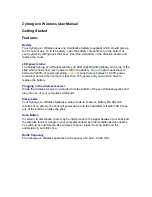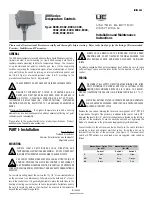
14
(1) (2) (3) (4)
(1) As it goes to transmission, PTT turns ON and starts transmitting the Flag signal. The Flag signal is to show the
partition of the packet and to synthesize the data clock.
(2) The data transmission is held until the TXDELAY time elapses. The TXDELAY must be calculated including
the physical timing of the RX/TX change of the radio, and the Flag period of the reception side of the packet.
The Sleep feature is not recommended, but if it is activated at the reception side, it must be considered to
determine the delay period.
(3) When the TXDELAY period is elapsed, the packet data will start transmitting.
(4) PTT is released when the packet is sent.
4-2-1 PPERSIST command
Abbrev. PP default: ON parameter: ON/OFF
example: PP ON
This command selects whether the P-PERSIST CSMA system is enabled or not. If it’s ON, it enters the PP
CSMA mode. It detects the carrier, and when the channel is empty, it starts generating the code for a slot. This is
to avoid all waiting stations starting their transmissions at the same time causing a conflict. In the OFF position,
the system remains Persistent CSMA. The unit transmits after the DWAIT period is elapsed.
4-2-2 PERSIST command
Abbrev. PE default: 128 parameter 0 to 255
example: PERSIST 63
This will select the parameter of the P-Persistent CSMA random code “hit” probability as previously described.
If the higher number is set, the chance to “hit” increases but the potential conflict with others also may increase.
If you set the value lower, the risk of conflict decreases but you cannot transmit a sequence of packets rapidly.
4-2-3 SLOTTIME command
Abbrev. SL default:3 parameter: 0 to 255
example: SL 5
This sets the time to generate a new random code for the P-Persistent CSMA system as previously described. It
is set in 10 microsecond units.
4-2-4 DWAIT command
Abbrev. DW default: 30 parameter: 0 to 255
example: DWAIT 10
Sets the time delay between the end of others’ transmission and your initiating a transmission. It is
recommended that this be set slightly different at each station in order to avoid conflicts.
4-2-5 SOFTDCD
Abbrev. Not available default: OFF parameter ON/OFF
Example: SOFTDCD ON
This selects the method of carrier detection. If this is ON, it detects a carrier using internal software. If the
incoming signal is digital data, it considers “the channel is in use”. If it is OFF, it detects signals using the status
of SQUELCH (SQ) terminal (the 3
rd
pin) on the CPU. If SQ is in the LOW position it considers “the channel is in
use”.
In 9600 bps mode, the EJ-50U always considers “the SOFTDCD command is in use”. If this is the case, change
this parameter to ON position. When set to ON, the transceiver can be run with an “open” or no squelch setting.















































